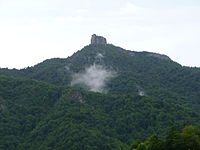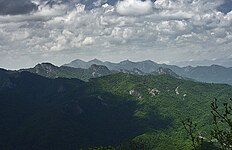Kachaghakaberd
 | |
 | |
| 39°58′17.0″N 46°36′53.5″E / 39.971389°N 46.614861°E | |
| Location | between the villages of Kolatak and Khndzristan in Khojaly District of Azerbaijan |
|---|---|
| Type | Fortress |
| Completion date | 9th century |
Kachaghakaberd (Armenian: Կաչաղակաբերդ, Azerbaijani: Qaxaç qalası) is a mountain-top fortress located between the villages of Kolatak and Khndzristan, in Khojaly District of Azerbaijan.[1]
The Janapar Trail runs very near to the fortress. A short side trail takes to the top of the fortress.
Etymology[edit]

Kachaghakaberd is translated from Armenian as magpie's fortress, a combination of the words կաչաղաք (kachaghak, designating the bird magpie) and բերդ (berd, meaning fortress).[2][3]
Architecture[edit]
The fortress was an important fortification of the medieval Armenian Principality of Khachen that thrived in the High Middle Ages,[4] and is located at a height of more than 1700 meters, surrounded by vertical limestone cliffs with the heights of 50–60 meters, has a hard-to-reach entrance from the southern side of the fortress. During its history no one could ever storm the fortress. Parts of the defensive walls remain standing.[5]
The territory of the fortress occupies a large area, though it seems small. Many rooms, secret passages cut into the cliffs, and special loopholes for throwing stones at enemies are inside its territory.[6] The water supply problem was solved by a unique method: two rock-cut reservoirs to store rain and melt-water are in the center of the fortress. Fresh water was brought from a spring at the foot of the mountain.[7]
Gallery[edit]
-
View of the tower
-
View from the tower
-
View of Kolatak village from the tower
See also[edit]
References[edit]
- ^ "Качагакаберд".
- ^ Brady Kiesling (Author), Raffi Kojian (Author, Editor). Rediscovering Armenia. Publisher: Matit; 2nd edition (June 1, 2005), ISBN 9994101218; ISBN 978-9994101214
- ^ Shahen Mkrtchian. Historical and Architectural Monuments of Nagorno-Karabakh. pp. 10, 21, 25. Yerevan, 1989, in Russian. Original: Шаген Мкртчян. Историко-архитектурные памятники Нагорного Карабаха. стр. 10, 21, 25. Ереван, 1989
- ^ Bonnie Marshall. The Flower of Paradise and Other Armenian Tales (World Folklore Series). 2007. photo section
- ^ Boris Baratov. Paradise Laid Waste: A Journey to Karabakh, Lingvist Publishers, Moscow, 1998, pp. 50
- ^ Shahen Mkrtchian. Historical and Architectural Monuments of Nagorno-Karabakh. pp. 10, 21, 25. Yerevan, 1989, in Russian. Original: Шаген Мкртчян. Историко-архитектурные памятники Нагорного Карабаха. стр. 10, 21, 25. Ереван, 1989
- ^ Brady Kiesling (Author), Raffi Kojian (Author, Editor). Rediscovering Armenia. Publisher: Matit; 2nd edition (June 1, 2005), ISBN 9994101218; ISBN 978-9994101214







